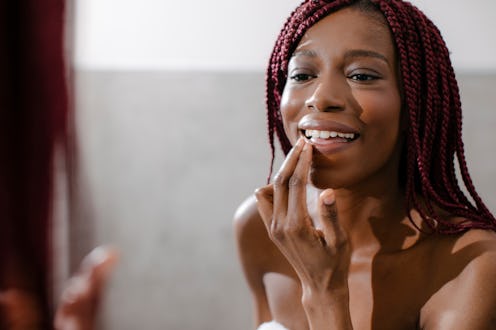(Skin)
This Is Why You Have Cracks In The Corners Of Your Mouth
There's a name for it.

"I think you just need to drink more water," my mom tells me a month or so ago when I was complaining to her about the painful cracks in the corners of my mouth. She's not wrong — my lack of water consumption certainly isn't helping my dry lips. But, after a bit of Googling, I discovered the actual diagnosis for these irritating (sometimes bloody) slits is separate from my chapped pout. As it turns out, the name for it is angular cheilitis. While this might sound serious, rest assured, it can easily be treated.
According to Dr. Sonia Badreshia-Bansal, a board-certified dermatologist and RealSelf advisory board member, angular cheilitis is inflammation of the corners of the mouth causing red, swollen patches where your lips meet and make an angle. "It can cause skin breakdown, crusting, itching, and pain lasting a few days, or become chronic," she explains. And all ages can be affected by this, the dermatologist adds.
You might be wondering, how exactly is this different from chapped lips? "Angular cheilitis more commonly involves the corners of the mouth and can spread to surrounding skin, and is typically more intense than just dry, cracked lips," Dr. Kelly Bickle, a board-certified dermatologist in Los Angeles, explains. Plus, Dr. Michelle Henry, a New York-based board-certified dermatologist, says chapped lips are caused by dryness, whereas angular cheilitis occurs from inflammation. "It is commonly caused by saliva pooling in that area, which can make it prone to bacteria or yeast, which can cause inflammation," she explains. "You can have dry lips without them being inflamed."
Though it might be a tad more severe than your common dry, crusty lips in the winter — don't panic. Ahead, TZR tapped dermatologists to get the low-down on angular cheilitis, and how to best treat it.
Angular Cheilitis: The Causes & Symptoms
Dr. Diane Madfes, a New York City-based dermatologist and Assistant Professor of Dermatology at Mount Sinai School of Medicine, says moisture is the culprit of angular cheilitis as it gathers whether from saliva or exhaled moist air. "Saliva gathers in the corners of the mouth irritating the skin contributing to an overgrowth of yeast," she explains. "Other causes besides increased moisture are drooling, vitamin deficiencies, such as zinc and vitamin B, and allergic reactions." And, Dr. Henry says eczema can cause irritation or inflammation in that area as well.
Additionally, Dr. Bickle says masks can also lead to angular cheilitis. "Frequent mask-wearing can create a warm, moist environment for the skin covered by the mask, which can allow for yeast to overgrow," the dermatologist explains. Plus, she notes that masks can also create irritation to more sensitive skin types, whether it be from the material of the mask or the detergent used to clean it. "This can contribute to breaking down of the skin, allowing for bacteria, yeast, and viruses to enter."
There are a few different symptoms of angular cheilitis to look out for. Dr. Madfes says the most common signs are cracking, redness, and a burning sensation. And, according to Dr. Badreshia-Bansal, those who are prone to angular cheilitis are ones with a history of infection such as thrush, immunocompromised, sensitive skin, smokers, or those with frequent use of corticosteroids or antibiotics.
Angular Cheilitis: How To Treat It
To cure angular cheilitis, you'll want to first treat the yeast. Dr. Madfes says to do this, apply an over-the-counter antifungal, like Lamisil's AT Antifungal Cream, twice a day, with a protective balm over it. To add to that, Dr. Bickle recommends protecting the skin with a thick barrier ointment like Aquaphor or vaseline. But, more importantly, Dr. Madfes encourages those to try to stop locking, biting, and picking at their lips. "As saliva evaporates the lips actually become drier," she says. "If it doesn’t get better with topical care, please see a dermatologist as lesions around the mouth can be a sign of other internal problems like vitamin deficiencies, cancerous spots, or sun damage." While prescription medications like oral Diflucan or topical ketoconazole cure angular cheilitis faster, Dr. Madfes says the key to keeping it away is a good lip routine — which consists of using a topical antifungal in the corners of the mouth and a barrier cream or ointment over the corners and entire lip, applied twice day.
We only include products that have been independently selected by TZR's editorial team. However, we may receive a portion of sales if you purchase a product through a link in this article.
This article was originally published on